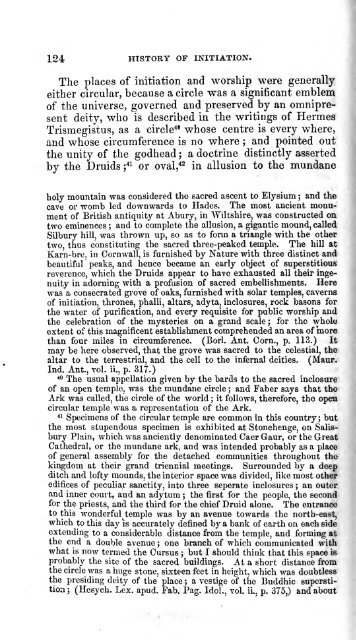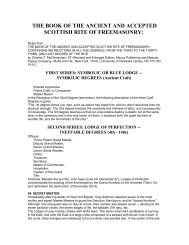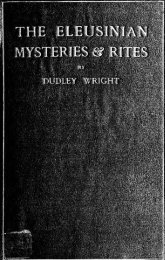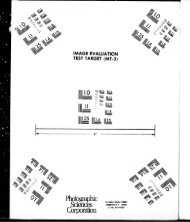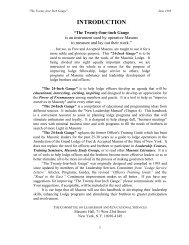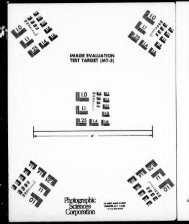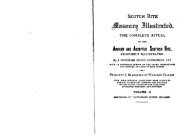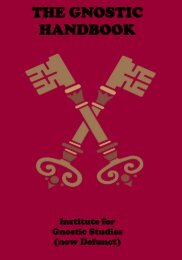The History of Initiation - The Masonic Trowel
The History of Initiation - The Masonic Trowel
The History of Initiation - The Masonic Trowel
You also want an ePaper? Increase the reach of your titles
YUMPU automatically turns print PDFs into web optimized ePapers that Google loves.
124<br />
HISTORY OF INITIATION.<br />
<strong>The</strong> places<br />
<strong>of</strong> initiation and worship were generally<br />
either circular, because a circle was a significant emblem<br />
<strong>of</strong> the universe, governed and preserved by an omnipresent<br />
deity, who is described in the writings <strong>of</strong> Hermes<br />
Trismegistus, as a circle4 * whose centre is every where,<br />
and whose circumference is no where and ; pointed out<br />
the unity <strong>of</strong> the godhead a doctrine ; distinctly asserted<br />
by the Druids 41 or ; oval, 42 in allusion to the mundane<br />
holy mountain was considered the sacred ascent to Elysium and the<br />
;<br />
cave or womb led downwards to Hades. <strong>The</strong> most ancient monument<br />
<strong>of</strong> British antiquity at Abury, in Wiltshire, was constructed on<br />
two eminences and to ; complete the allusion, a gigantic mound, called<br />
Silbury hill, was thrown up, so as to form a triangle with the other<br />
two, thus constituting the sacred three-peaked temple. <strong>The</strong> hill at<br />
Karn-bre, in Cornwall, is furnished by Nature with three distinct and<br />
beautiful peaks, and hence became an early object <strong>of</strong> superstitious<br />
reverence, which the Druids appear to have exhausted all their ingenuity<br />
in adorning with a pr<strong>of</strong>usion <strong>of</strong> sacred embellishments. Here<br />
was a consecrated grove <strong>of</strong> oaks, furnished with solar temples, caverns<br />
<strong>of</strong> initiation, thrones, phalli, altars, adyta, inclosures, rock basons for<br />
the water <strong>of</strong> purification, and every requisite for public worship and<br />
the celebration <strong>of</strong> the mysteries on a grand scale; for the<br />
\yhole<br />
extent <strong>of</strong> this magnificent establishment comprehended an area <strong>of</strong> more<br />
than four miles in circumference. (Borl. Ant. Corn., p. 113.) It<br />
may be here observed, that the grove was sacred to the celestial, the<br />
altar to the terrestrial, and the cell to the infernal deities. (Maur.<br />
Ind. Ant, vol. ii., p. 317.)<br />
40 <strong>The</strong> usual appellation given by the bards to the sacred inclosure<br />
and Faber says that the<br />
<strong>of</strong> an open temple, was the mundane circle ;<br />
Ark was called, the circle <strong>of</strong> the world it ; follows, therefore, the open<br />
circular temple was a representation <strong>of</strong> the Ark.<br />
41<br />
Specimens <strong>of</strong> the circular temple are common in this country; but<br />
the most stupendous specimen is exhibited at Stonehenge, on Salisbury<br />
Plain, which was anciently denominated Caer Gaur, or the Great<br />
Cathedral, or the mundane ark, and was intended probably as a place<br />
<strong>of</strong> general assembly for the detached communities throughout the<br />
kingdom at their grand triennial meetings. Surrounded by a deep<br />
ditch and l<strong>of</strong>ty mounds, the interior space was divided, like most other<br />
edifices <strong>of</strong> peculiar sanctity, into three seperate inclosures an outer<br />
;<br />
and inner court, and an adytum the first for the ; people, the second<br />
for the priests, and the third for the chief Druid alone. <strong>The</strong> entrance<br />
to this wonderfuHemple was by an avenue towards the north-east,<br />
which to this day is accurately defined by a bank <strong>of</strong> earth on each side<br />
extending to a considerable distance from the temple, and forming at<br />
the end a double avenue ; one branch <strong>of</strong> which communicated with<br />
what is now termed the Cursus but I should think that this ; space is<br />
probably the site <strong>of</strong> the sacred buildings. At a short distance from<br />
the circle was a huge stone, sixteen feet in<br />
height, which was doubtless<br />
the presiding deity <strong>of</strong> the place a ; vestige <strong>of</strong> the Buddhic superstition<br />
; (Hesych. Lex. apud. Fab. Pag. Idol., vol. ii.. p. 375,) and about


